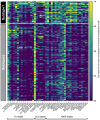Subtypes of tic disorders in children and adolescents: based on clinical characteristics
- PMID: 40312306
- PMCID: PMC12046735
- DOI: 10.1186/s12887-025-05698-2
Subtypes of tic disorders in children and adolescents: based on clinical characteristics
Abstract
Background: Tic disorder (TD) is a diverse neurodevelopmental disorder with various symptoms and comorbidities. Traditional classifications based on age onset and duration fail to adequately characterize the full clinical features of TD. This study aims to redefine TD subtypes by a comprehensive analysis of clinical features and comorbidities.
Methods: We assessed 139 children and adolescents aged 6-18 years using 14 scales covering 43 dimensions. The k-means clustering algorithm was used to identify distinct TD subtypes. Differences between these subtypes were analyzed using t-tests and network analysis, with high expected influence (EI) metric representing key symptoms within each subtype.
Results: We identified two distinct subtypes of TD, with 21.6% of participants classified as subtype1 and 78.4% as subtype2. Subtype1 exhibited more severe symptoms across TD, obsessive-compulsive spectrum disorders, and attention deficit hyperactivity disorder assessments compared to subtype2, with significant differences observed in 81.4% of the scale features. Network analysis revealed differences in core symptoms between the two subtypes; subtype1 primarily involved hyperactivity and vital activities, whereas subtype2 primarily involved attention deficit, hyperactivity and conduct. Furthermore, comparisons with DSM-5 classifications revealed distinct patterns, indicating the novel nature of the identified subtypes.
Conclusion: Our study identified two novel TD subtypes, highlighting its heterogeneity. Subtype 1 had more severe attention deficits and impulsivity, requiring comprehensive treatment, while subtype 2 had milder symptoms, focusing on support and monitoring. These findings provide insights into TD classification and may help refine treatment strategies. However, the cross-sectional design limits causal interpretations, and reliance on parent-reported data may introduce bias.
Keywords: Clinical characteristics; Cluster analysis; Subtype classification; Tic disorder.
© 2025. The Author(s).
Conflict of interest statement
Declarations. Competing interests: The authors declare no competing interests.
Figures





Similar articles
-
Clinical symptoms and functional impairment in attention deficit hyperactivity disorder (ADHD) co-morbid tic disorder (TD) patients: a cluster-based investigation.BMC Psychiatry. 2025 Feb 4;25(1):100. doi: 10.1186/s12888-025-06558-0. BMC Psychiatry. 2025. PMID: 39905386 Free PMC article.
-
[Compulsive phenomena in children with tic disorder and attention deficit-hyperactive disorder].Z Kinder Jugendpsychiatr Psychother. 2003 Aug;31(3):203-11. doi: 10.1024/1422-4917.31.3.203. Z Kinder Jugendpsychiatr Psychother. 2003. PMID: 12942792 German.
-
Clinical features of tic-related obsessive-compulsive disorder: results from a large multicenter study.CNS Spectr. 2012 Jun;17(2):87-93. doi: 10.1017/S1092852912000491. CNS Spectr. 2012. PMID: 22789066
-
[Treatment-refractory OCD from the viewpoint of obsessive-compulsive spectrum disorders: impact of comorbid child and adolescent psychiatric disorders].Seishin Shinkeigaku Zasshi. 2013;115(9):990-6. Seishin Shinkeigaku Zasshi. 2013. PMID: 24228477 Review. Japanese.
-
Tourette syndrome in a longitudinal perspective. Clinical course of tics and comorbidities, coexisting psychopathologies, phenotypes and predictors.Dan Med J. 2018 Apr;65(4):B5465. Dan Med J. 2018. PMID: 29619935 Review.
References
-
- Li F, Cui Y, Li Y, Guo L, Ke X, Liu J, et al. Prevalence of mental disorders in school children and adolescents in China: diagnostic data from detailed clinical assessments of 17,524 individuals. J Child Psychol Psychiatry. 2022;63(1):34–46. - PubMed
MeSH terms
Grants and funding
LinkOut - more resources
Full Text Sources

